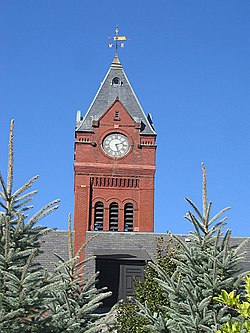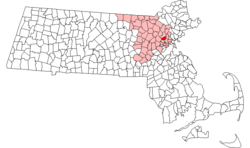Winchester, Massachusetts
| Winchester, Massachusetts | ||
|---|---|---|
| Town | ||

Winchester Town Hall
|
||
|
||
 Location in Middlesex County in Massachusetts |
||
| Coordinates: 42°27′08″N 71°08′15″W / 42.45222°N 71.13750°WCoordinates: 42°27′08″N 71°08′15″W / 42.45222°N 71.13750°W | ||
| Country | United States | |
| State | Massachusetts | |
| County | Middlesex | |
| Settled | 1640 | |
| Incorporated | 1850 | |
| Government | ||
| • Type | Representative town meeting | |
| Area | ||
| • Total | 6.3 sq mi (16.3 km2) | |
| • Land | 6.0 sq mi (15.6 km2) | |
| • Water | 0.3 sq mi (0.6 km2) | |
| Elevation | 62 ft (19 m) | |
| Population (2010) | ||
| • Total | 21,374 | |
| • Density | 3,522.8/sq mi (1,354.9/km2) | |
| Time zone | Eastern (UTC-5) | |
| • Summer (DST) | Eastern (UTC-4) | |
| ZIP code | 01890 | |
| Area code(s) | 339 / 781 | |
| FIPS code | 25-80510 | |
| GNIS feature ID | 0618247 | |
| Website | http://www.winchester.us/ | |
Winchester is a small suburban town located in Middlesex County, Massachusetts, 8.2 miles north of downtown Boston. It is the 7th wealthiest municipality in Massachusetts, and functions largely as a bedroom community for professionals who work in the greater Boston area. The population was 21,374 at the 2010 United States Census.
The land on which Winchester now sits was purchased from Native Americans by representatives of the settlement of Charlestown in 1639, and the area was first settled by Europeans in 1640. In the early years of the settlement, the area was known informally as Waterfield, a reference to its many ponds and to the river which bisected the central village. In its second century, the area was referred to as Black Horse Village, after the busy tavern and hostelry in its center.
Until the middle of the 19th century, parts of Arlington, Medford, Cambridge, and Woburn comprised what is now Winchester. The movement toward incorporation of what, by this time, was called South Woburn was likely precipitated by the rise of the Whig Party in Massachusetts (History of Winchester, Massachusetts by H. S. Chapman and Bruce W. Stone, 1936, 1975).
The Whigs sought to split a new jurisdiction away from heavily Democratic Woburn and found enough supporters in the burgeoning village to organize a movement toward incorporation. Representatives of the planned new town selected the name Winchester in recognition of Colonel William P. Winchester of nearby Watertown, who pledged $3,000 toward the construction of the first town hall. Upon the signature of then Governor Briggs, the town of Winchester was officially incorporated on April 30, 1850. Colonel Winchester did not live to visit the town that had honored his family name. He succumbed to typhoid fever within months of its incorporation.
The town's early growth paralleled improvements in transportation. Prior to incorporation, the Middlesex Canal, linking the Merrimack River to Boston, was completed through then Waterfield. It flourished from 1803–36, until the Boston and Lowell Railroad completed a line which neatly bisected the town and provided it with two stations. Able to deliver passengers as well as goods, the railroad soon bankrupted the canal and spurred more people to move to the area. The first church was built in 1840, the Post Office followed in 1841, and soon after incorporation town schools were started. Industries small and large followed, including the Beggs and Cobb tannery and the Winn Watch Hand factory which would operate well into the 20th century.
...
Wikipedia

